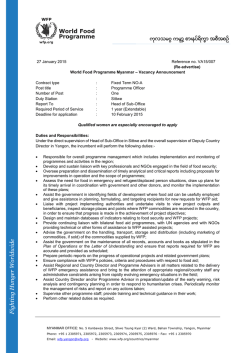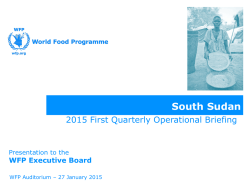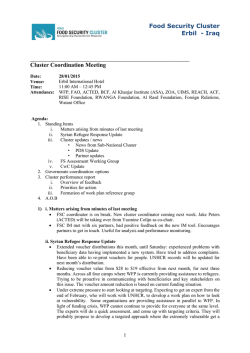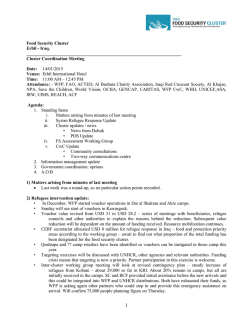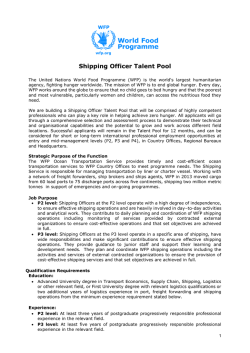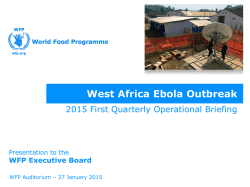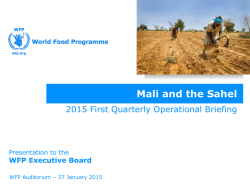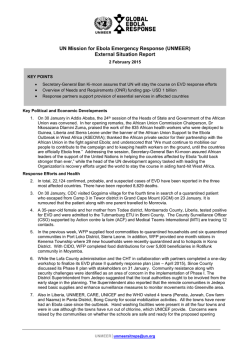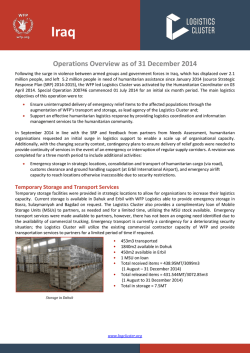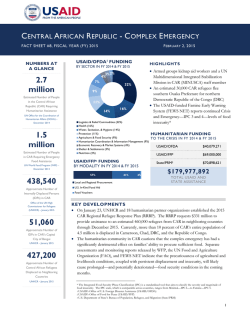
Global Overview - WFP Remote Access Secure Services
Global Overview WFP Global Overview, 27 January 2015 Operational Briefing, 27 January 2015 Emergencies Central African Republic (L3) ....................................................................................... 2 Iraq (L3) .................................................................................................................. 5 Syria (L3) ................................................................................................................. 8 Democratic Republic of Congo (L2) ............................................................................ 13 Somalia (L2) ........................................................................................................... 16 Libya (L2 since 26 November 2014) ........................................................................... 19 Ukraine (L2 since 26 November 2014) ........................................................................ 22 Yemen (L2) ............................................................................................................. 25 Malawi.................................................................................................................... 28 Insecurity in Northern Nigeria ................................................................................... 31 Page 1 of 33 Central African Republic (L3) Situation Analysis WFP Global Overview, 27 January 2015 Security / Political Situation The security situation in C.A.R. remains extremely volatile. Communitarian and sectarian clashes, coupled with a tense political context, spilled over into a vicious cycle of violence, affecting thousands of civilians. As of January 2015, fighting is concentrated around eight central and western prefectures, as well as in Bangui. 2.7 million people are in need of immediate humanitarian assistance. The conflict in C.A.R. has led to the displacement of close to 900,000 people; 438,500 people within the country (including 62,000 in Bangui), and 423,300 people who fled to neighbouring countries (Chad, DRC, Republic of Congo and Cameroon). MINUSCA officially took over operations on 14 September 2014, under a one-year mandate. It numbers 6,500 troops and 1,000 police and is expected to expand to 12,000 by February 2015, replacing the 4,800-strong African Union peacekeeping force previously active in CAR. In October 2014, violence erupted in Bangui, with militia groups directly targeting MINUSCA forces and UN humanitarian agencies. This further hampered WFP’s ability to bring food to people in need, in a country where humanitarian operations are constantly being hindered by poor roads, banditry, looting and random violence by militias. Tension, rioting and threats of violence in Bangui continued into November and December. Food Security More than 1.5 million people are suffering from food insecurity – one-third of the population – and food reserves in rural areas are now up to 50 percent lower than average levels, following recurring raids and continuous displacement of farming communities. The lean season, when food from the last harvest runs out, is expected to begin in January 2015. Programming Situation Regional EMOP 200799 “Critical support to populations affected by the ongoing crisis in the Central African Republic and its regional impact” (Jan 2015 – Dec 2015). The new regional operation integrates activities carried out in 2014 in both C.A.R. and for refugees and host communities in neighbouring countries. Overall, WFP will assist 1.5 million people in 2015. SO 200804 “Provision of Humanitarian Air Services in C.A.R.” (Jan 2015 – Dec 2015). A US$15.5 million Special Operation is being finalized which will enable the WFP-managed UN Humanitarian Air Service to operate in the country, serving 28 regular destinations with three aircraft. Page 2 of 33 DEV 200331 “Central African Republic (2012-2016) Strengthening Support to Education and Nutrition in CAR” (Jan 2012- Dec 2016) is currently paused. The programme supported school meals to primary and pre-school children and provided nutritional support to malnourished children, pregnant women and nursing mothers. WFP Global Overview, 27 January 2015 Access Violent attacks, threats against aid workers and roadblocks hinder the supply of humanitarian assistance outside Bangui. Within Bangui, recent developments, including violence and obstruction by armed groups have impacted negatively on humanitarian access, with various actors suspending activities in the capital and looting of warehouses and trucks increasingly an issue. Heightened insecurity has resulted in some postponed or halted distributions by WFP as well as other organizations. Resourcing The new Regional EMOP which began on 01 January 2015, is funded at 4 percent of project needs, which amount to US$196.5 million. Capacity WFP is responding to an extraordinary level of humanitarian need in five Level 3 emergencies; the greatest number of emergencies of this type to happen at the same time since the categorization system was introduced in 2011. Due to this, WFP is having difficulties finding the highly qualified francophone staff needed to fill critical positions in the Country Office. Inter-Agency WFP is contributing appealing for US$128 million as part of the 2015 C.A.R. Strategic Response Plan worth US$613 million, and the regional Refugee Response Plan that is appealing for US$298 million (preliminary estimate pending confirmation in February). WFP works in close collaboration with humanitarian actors via the cluster system (including the food security, logistics and ETC clusters which are all active) as well as other humanitarian architecture present in the country. WFP works closely with FAO and the Government on food security assessments, making sure responses are guided by accurate and timely food security analyses. Risks Continued communal violence - also affecting Chad, Cameroon and DRC Page 3 of 33 Page 4 of 33 WFP Global Overview, 27 January 2015 Iraq (L3) Situation Analysis WFP Global Overview, 27 January 2015 Security / Political Situation The security and humanitarian situation remains uncertain and dire. Recurrent battles continue to be reported in north-central regions, around Tikrit and Samarra in Salah al-Din governorate, in Diyala governorate and in northern Kirkuk. ISIL still has considerable freedom of movement and operation in Sunni strongholds, including key cities such as Mosul. Airstrikes have not diminished ISIL’s capacity to mount attacks or hold territory, though the pace of ISIL’s advance has slowed. Military operations are reportedly under preparation to move against ISIL controlled areas, including Mosul and areas in Diyala. This would likely cause additional displacement and could increase accessibility in the medium term. At the end of 2014, IOM recorded 2.1 million IDPs in Iraq, up from two million in November. Of these, half a million people have been displaced for almost one year. They were a part of the first wave of displacement, following the outbreak of conflict in Anbar Governorate. The latest increase was due to people continuing to flee their homes in the central and north-central regions. Food Security An estimated 2.2 million people across Anbar, Kirkuk, Diyala, Ninewa and Salah al-Din governorates are suffering from food insecurity and require urgent assistance. Food security conditions are likely to deteriorate, with large numbers of IDPs putting strain on host communities, particularly as a large share of IDPs have fled towards cities in the Kurdish region of Iraq. According to the Ministry of Agriculture, Iraq lost 40% of its agricultural production capacity after ISIL took control of the most productive provinces. Programming Situation EMOP 200677 “Emergency Assistance to Populations Affected by the Iraq Crisis” (April 2014 – April 2015) aims at responding to the needs of people displaced by the conflict. WFP targets 1.68 million people in January 2015. PRRO 200035 “Support to Vulnerable Groups” (August 2010 – February 2015) aims to implement capacity building activities under the Social Safety Net programmes. The PRRO was put on hold due to the crisis and there are no planned distributions. Access WFP has not halted distributions in Dohuk and Sulaymaniyah governorates amid snow and freezing temperatures in the last weeks. In January, WFP was able to access Salah al-Din governorate for first time since food distributions took place in Amerli district in September 2014. Dhuluiya was under siege by ISIL for several months, with shortages of food commodities and medicines reported. In partnership with Mercy Corps, WFP Page 5 of 33 WFP Global Overview, 27 January 2015 distributed Immediate Response Rations in the recently liberated district of Dhuluiya in Salah al-Din, assisting approximately 2,500 people. The continuing instability in Kirkuk and other central-northern regions is severely limiting humanitarian access. There is grave concern for the food security of people in the besieged cities of Al Baghdadi and Haditha in Anbar governorate, which are reported to be suffering serious shortages of food and medicines. Anbar representatives in January called for an increase in humanitarian assistance for approximately 700,000 IDPs in the governorate. Although the security situation has hindered humanitarian access in Anbar, WFP plans to reach 66,000 people in the governorate during January. Resourcing Significant funding gaps are affecting the operation and are putting WFP’s ability to adequately respond at risk. The EMOP requires an additional US$200 million until December 2015. The increased requirements come as a result of a budget revision, initiated in response to the increasing number of people displaced by violence, and in line with inter-agency planning. Additional funding is urgently required to prevent a partial pipeline break for vouchers in March, and a complete pipeline break for all types of food assistance in April. Capacity WFP reached 838,194 beneficiaries in Iraq in December. WFP operations were hampered by late deliveries from food suppliers in Turkey and access constraints in contested areas. In February, WFP plans to reach 1.3 million beneficiaries by Family Food Parcels, 420,000 by Food Vouchers and 100,000 by Immediate Response Rations. Inter-Agency A joint initiative with UNICEF and a consortium of five international NGOs, the Rapid Response Mechanism pairs WFP three day ready-to-eat Immediate Response Rations with UNICEF hygiene kits and bottled water, to provide a package of complementary assistance designed for a family of five. Stocks are pre-positioned with partners in strategic locations, enabling a fast response to new displacements and returnees. WFP leads the Logistics and the Emergency Telecommunications Clusters (ETC) and co-leads with FAO the Food and Agriculture Cluster. The CERF approved a US$5.1 million allocation to the Food Security Cluster, US$4.7 million has been assigned to WFP. The project will provide lifesaving food assistance to people affected by the recent displacement in Kirkuk, Anbar, Diyala and Sulaymaniyah governorates. Risks Armed conflict involving Iraqi Armed Forces, supported by Sunni and Shia militias as well as Iranian troops and US-led airstrikes, and ISIL militants. Page 6 of 33 Page 7 of 33 WFP Global Overview, 27 January 2015 Syria (L3) Situation Analysis WFP Global Overview, 27 January 2015 Security / Political Situation The security situation in Syria continues to be extremely volatile, with daily fighting between Syrian Government troops and rebels, including ISIL, Jabhat-al-Nusra and other opposition groups. Airstrikes also continue on a daily basis, targeting ISIL position throughout the country. According to the Syrian Observatory for Human Rights (SOHR), 2014 was the deadliest year since the conflict began in 2011, with more than 76,000 Syrians dead. In Kobane, according to SOHR, Kurdish fighters along with Peshmerga and backed by airstrikes have reportedly regained control of 90% of the town on 26 January, after more than four months of fighting against ISIL. UN Special Envoy Staffan de Mistura recently urged implementation of UN Security Council resolutions on humanitarian access, foreign fighters and terrorist groups and also urged support for the proposal of a freeze to heavy fighting in Aleppo. Meanwhile, talks between Syrian Government and opposition started in Moscow on 26 January but the main opposition group – the National Coalition for Syrian Revolutionary and Opposition Forces – has already said it will not attend the four days of talks. According to OCHA, 7.6 million people are estimated to be internally displaced within Syria. UNHCR estimates that there are almost 3.8 million refugees in the region. Food Security In many areas of Syria, food security is deteriorating because of the continuing civil war, international sanctions, disrupted food production, and hikes in domestic fuel and food prices. According to the Food Security and Agriculture Cluster analyses, 9.8 million are people are considered to be food insecure, of which 6.8 million are severely and 3 million moderately food insecure. Although international food assistance is being provided, Syrian refugees are putting strain on host communities in neighbouring countries. In addition, drought conditions resulted in poor harvests in the main regional producing countries and is likely to affect Syria’s already-fragile food security situation. Programming Situation EMOP 200339 “Emergency food assistance to people affected by unrest in Syria” (Oct 2011 – Dec 2015) aims to provide monthly life-saving emergency food assistance to vulnerable households whose food and nutrition security has been adversely affected by the civil unrest, across all 14 Governorates. Through a recent Budget Revision, the program increased the response to address the food needs of around 4.5 million beneficiaries every month, through a combination of emergency food assistance and livelihoods strengthening activities. Page 8 of 33 WFP Global Overview, 27 January 2015 Regional EMOP 200433 “Food assistance to vulnerable Syrian populations in Jordan, Lebanon, Iraq, Turkey and Egypt affected by the conflict in Syria” (Jul 2012 – Dec 2015) aims to provide immediate food assistance to food-insecure refugees in the countries neighbouring Syria, mainly through vouchers. According to a recent budget revision that extended the EMOP up to December 2015, the number of monthly targeted beneficiaries for 2015 is 2.1 million. Access Conflict zones are extremely challenging to access. Access to Ar-Raqqa has been a major challenge for WFP, allowing only sporadic and insufficient deliveries of food assistance since October 2013. Almost 600,000 people are in urgent need of food assistance in Deir Ezzor and Ar-Raqqa governorates, and a further 1 million people are at risk of food insecurity. Assessments in opposition-held areas of Al-Hassakeh have found high levels of food insecurity. Resourcing WFP’s funding situation for operations in Syrian and the region remains critical. WFP requires around US$ 300 million (US$126 million in the region and US$174 million for Syria) over the next three months (January-March). Under the UN’s 2015 Syria Strategic Response Plan and the Regional Refugee and Resilience plan, WFP has appealed for more than US$1.5 billion to feed over 6.5 million people inside Syria and sheltering in neighbouring countries. Capacity In 2014, WFP food assistance reached a record number of people in Syria and in the region (4.1 million in Syria reached in August and 1.9 million in the region reached in December). The passing of UN Security Council Resolutions 2139 and 2165 significantly strengthened WFP’s ability to reach people in need in hard-to-reach and besieged areas. Through a combination of regular food deliveries, cross-line inter-agency convoys, emergency airlifts and cross-border deliveries from Turkey and Jordan, food for almost 3.8 million civilians living in these areas was delivered over the course of 2014. More than 550,000 of these were reached through cross-border deliveries from Turkey and Jordan, with a significant scale-up planned for 2015 - should the required cooperating partnerships, funds, and access conditions materialize. Despite access difficulties, WFP and its cooperating partners distributed food in all 14 Syrian governorates through a network of seven warehouses and five packaging facilities across the country. Deliveries to the northeastern governorates of Hassakeh, Deir-ez-Zor and Ar-Raqqa were particularly challenging. WFP moves some 60,000 metric tons of food each month across Syria. This involves over 3,000 trucks navigating through hundreds of checkpoints controlled by troops and armed groups. Page 9 of 33 Since the start of operations, WFP has injected around US$1 billion into regional economies through voucher/e-card assistance, US$621 million of it in 2014. Inter-Agency WFP Global Overview, 27 January 2015 WFP leads the Logistics and the Emergency Telecommunications sectors and co-leads with FAO the Food Security and Agriculture sector. On 06 January, WFP launched the OneCard system in partnership with UNICEF to support their winterization programme, reaching a total of 41,000 children under the age of 14 in Azraq and Za’atri camps. This programme enabled refugees to buy winter clothes, such as boots, gloves, trousers, coats and scarves using their WFP ecards at WFP-contracted supermarkets in the camps. WFP launched a school feeding programme in Syria in partnership with UNICEF and the Ministry of Education. The programme will expand in 2015 to support 500,000 students in areas of high concentration of IDPs including Tartous, Aleppo, Rural Damascus and Al-Hassakeh. The children receive date bars to encourage them to enrol and stay in school. Risks Armed conflict involving the pro-Assad forces and anti-regime groups - also affecting Jordan, Iraq, Lebanon and Turkey Market disruptions and high commodity prices Page 10 of 33 Page 11 of 33 WFP Global Overview, 27 January 2015 Page 12 of 33 WFP Global Overview, 27 January 2015 Democratic Republic of Congo (L2) Situation Analysis WFP Global Overview, 27 January 2015 Security / Political Situation With the deadline for the full and unconditional surrender of the rebel Democratic Forces for the Liberation of Rwanda (FDLR) having passed on 02 January, and no significant additional surrenders of FDLR combatants registered since June 2014, MONUSCO and the DRC Armed Forces (FARDC) have started preparations for military operations against the FDLR on the basis of a joint plan. OCHA has warned that at least 368,000 people in North Kivu province and 118,000 in South Kivu may be affected by fighting as a result of the joint MONUSCO-FARDC intervention. A further 90,000 people could be affected as rebel fighters flee west into Oriental province. Food Security The combination of persistent insecurity, recurrent displacements, infrastructure deterioration and asset destruction have significantly affected food security in the DRC over the past two decades. According to the December 2014 Integrated Phase Classification (IPC), an estimated 4.8 million people are in a situation of acute food security and livelihood crisis. In total, seven territories are in a phase 4 situation (emergency) and 54 are in a phase 3 situation (crisis or partly in crisis). Programming Situation PRRO 200540 “Targeted Food Assistance to Victims of Armed Conflict and other Vulnerable Groups” (July 2013- Dec 2015) aims to assist 3.6 million beneficiaries from July 2013 to December 2015, providing life-saving food assistance for IDPs and refugees in crisis-affected areas; contributing to reducing the prevalence of acute malnutrition through nutrition support and treatment for children aged 6-59 months and to pregnant and nursing women; facilitating rehabilitation and reconstruction of roads, markets, productive, and social infrastructure. SO 200456 “Logistics Cluster Coordination and Road Infrastructure Repairs in Support of WFP and the Humanitarian Community in the Democratic Republic of Congo” (July 2012 – Dec 2014) aims to provide logistics support to the humanitarian community through Logistics Cluster activities and logistics services under WFP's leadership. SO 200504 “Provision of Humanitarian Air Services” (Jan. 2013 – Dec. 2014) UNHAS provides reliable links between Kinshasa and the eastern provinces, as well as access to deep-field locations within the eastern provinces and in Equatorial Province. SO 200661 “Strengthening Food Security Cluster Coordination in the Democratic Republic of Congo” (Mar 2014- Mar 2015) aims to deliver Page 13 of 33 predictable and accountable leadership and coordination in the food security cluster and strengthen existing national and local humanitarian management and coordination systems. Access WFP Global Overview, 27 January 2015 The combination of persistent insecurity, recurrent displacements, infrastructure deterioration and asset destruction have significantly affected WFP operations. Resourcing PRRO 200540 needs US$ 18 million from February to July in order to continue assisting to continue assisting refugees, newly displaced people, old but vulnerable IDPs, returnees, nutritionally vulnerable groups, and school children through emergency school feeding. Capacity With a view to increase impact in the context of limited resources, WFP will prioritize its interventions to achieve the following objectives: relief assistance to IDPs and refugees using the most effective combination of transfer modalities: cash, vouchers and food distributions; Focused school feeding in emergency and transitional contexts; Moderate Acute Malnutrition (MAM) treatment in priority areas; Prevention of acute malnutrition in areas where Global Acute Malnutrition (GAM) exceeds 15 percent; Support to returnees. Inter-Agency In DRC, WFP leads the Logistics Cluster and co-leads the Food Security Cluster with FAO. In 2015, UNHAS will continue to provide and expand flights to Equateur Province in 2015 in partnership with UNHCR. UNHAS will integrate its operation in DRC with C.A.R., recognizing operational linkage, this includes adding Bangui as a regular UNHAS destination. In Equateur Province, WFP works in close collaboration with UNHCR, UNICEF, WHO, FAO and UNFPA through the multi-sectoral response to the C.A.R. refugee emergency. The agencies contribute to the refugee program in their respective areas of competence as per the global Memorandum of Unerstandings in force or the local arrangements jointly agreed. All UN agencies implement their programs in collaboration with local and international implementing partners. Risks Armed conflict involving rebel groups, FARDC and MONUSCO – also affecting Uganda, Rwanda and Burundi Armed conflict involving MONUSCO, FARDC and Mayi Mayi Kata Katanga Page 14 of 33 Page 15 of 33 WFP Global Overview, 27 January 2015 Somalia (L2) Situation Analysis WFP Global Overview, 27 January 2015 Security / Political Situation On a political level, delays in the resolution of Somalia’s long-standing political crisis persist. The newly appointed Prime Minister Omar Abdirashid Ali Sharmarke on 12 January named a new cabinet. However, many former Ministers were retained, which led to criticism by Members of Parliament. The Parliament ultimately rejected the proposed cabinet and the Prime Minister needs to form a new cabinet by 31 January. The Intergovernmental Authority on Development (IGAD), European Union, African Union Mission in Somalia (AMISOM), the US and the UK have urged Somalia to ‘move swiftly’ towards the implementation of ‘Vision 2006’ through a new Cabinet endorsed by Parliament, warning that further delays ‘could jeopardize the progress Somalia has made towards building peace and security.’ The security situation in Mogadishu remains volatile, with an elevated level of Al Shabaab activity. The UN continues consultations with senior AMISOM and Federal Government of Somalia (FGS) officials on additional mitigation measures to address the continuing terrorist threat, in the aftermath of the 25 December 2014 infiltration attack in the AMISOM-protected Mogadishu International Airport area. Food Security According to the latest FEWS NET Food Security Outlook released in January 2015, over one million people will likely remain in Crisis and Emergency (IPC Phases 3 and 4) through June 2015. The most food insecure people will be in Hiraan agropastoral livelihood zone, southern riverine areas in Middle Juba, and Jowhar District in Middle Shabelle. Food insecurity in these areas is primarily the result river flooding that delayed crop production, limited access to humanitarian assistance, and continued high food prices due to trade restrictions. Programming Situation PRRO 200443 “Strengthening Food and Nutrition Security and Enhancing Resilience in Somalia” (Jan 2013 – Dec 2015) targets up to 2.9 million beneficiaries over three years and seeks to save lives, provide social safety nets and enhance the resilience of vulnerable individuals and households to cope more effectively during shocks. SO 200507 “Humanitarian Air Service in Support of Relief Operations in Somalia and Kenya” (Jan 2013 - Dec 2014) facilitates the delivery of life-saving humanitarian and movement of humanitarian workers in Somalia and Kenya. SO 200440 “Food Security Cluster Augmentation in Response to the Continued HumanitarianSituation in Somalia” (Sept 2012 - Dec 2014) enables Cluster members to move beyond seasonal-based response plans to address acute needs. Page 16 of 33 Access WFP Global Overview, 27 January 2015 Currently WFP has access to Puntland, Somaliland, the Central regions, and parts of southern Somalia (Kismayo, Mogadishu, Afgoye, Merka, Jowhar) as well as the Gedo region (Dolow, Luuq, El Berde, El Wak, Garbaharey) and areas in Bay and Bakool regions (Hudur, Wajid, Baidoa). Resourcing As of January 2015, PRRO 200443 faces a funding shortfall of US$73 million through May 2015. New contributions are needed to prevent WFP from having to drastically reduce the number of people we can assist. Capacity The humanitarian response, including WFP’s, is constrained by stretched resources and limited road access. WFP continues to monitor the humanitarian situation in areas affected by military operations and stands ready to respond. Inter-Agency WFP in coordination with the Logistics Cluster has been able to airlift specialized nutrition commodities to Hudur, Wajid and Baidoa, using small capacity aircrafts. Risks Armed conflict involving Al-Shabaab and joint forces High Prices and market disruptions Page 17 of 33 Page 18 of 33 WFP Global Overview, 27 January 2015 Libya (L2 since 26 November 2014) Situation Analysis WFP Global Overview, 27 January 2015 Security / Political Situation The conflict between nationalists and Islamist-backed militias that erupted in June 2014 after parliamentary elections led to a re-escalation of hostilities and violence across Libya, causing civilian casualties, massive displacement, destruction of public infrastructure and the disruption of basic social services and social protection systems. Libyan stakeholders took part in a first round of a UN-facilitated dialogue in Geneva on 14 and 15 January 2015. The dialogue was aimed at finding ways to end the country’s political, security and institutional crisis. Participants agreed on an agenda that includes reaching a political agreement to form a national unity government and the necessary security arrangements and called on all the parties to cease hostilities. They identified confidence-building measures such as providing humanitarian aid in affected areas. Food Security By nature, Libya’s agricultural production is very limited as is the domestic production of staple food crops. As a result, 80 percent of food requirements are imported, a figure that reaches up to 90 percent in the case of cereal consumption requirements. In normal times, the food market in Libya is highly subsidized, with some food items subsidized at 90 percent of their market value, in particular for cereal grains and flour, the staple of the Libyan diet. Insecurity has disrupted markets, trade routes and access to the Public Distribution System (PDS) and the national safety net programme, affecting both food supplies and access to food. Programming Situation Regional EMOP 200257 “Food Assistance to Vulnerable Populations Affected by Conflict” (2011 - Dec. 2014) aimed to provide General Food Distribution (GFD) to IDPs in Libya. The project was in its final phases, focusing on capacity development, when the security situation deteriorated, causing a new wave of displacements. As a response, WFP reoriented project priorities to target 10,000 families, equivalent to 50,000 beneficiaries, purchasing 575 mt of food which were delivered to WFP partners to be distributed to the most affected people. EMOP 200776 “Assistance to people affected by the crisis in Libya” (Nov. 2014 – March 2015) builds on EMOP 200257 and aims to provide food assistance to the most vulnerable displaced population affected by the political crisis and escalating violence in Libya, targeting a monthly average of 115,000 beneficiaries. As of 26 January 2015, WFP reached 68,670 beneficiaries. Access Due to the ongoing violence and highly volatile security situation, humanitarian access has been extremely limited, as UN agencies, donors and international NGOs have evacuated staff to neighbouring countries, e.g. Tunisia and Malta. WFP has not had a Page 19 of 33 WFP Global Overview, 27 January 2015 presence in Libya since 2012. The Libya UN Country Team (UNCT) is operating remotely from Tunisia until the situation allows for the deployment of staff to Libya. A WFP emergency coordinator for EMOP 200776 is based in Tunis. On 14 January 2015, UNDSS authorized the extension of the evacuation status for a further three months. WFP has established partnerships with NGO Taher el Zawi (TAZ) and the Libyan Red Crescent (LRC) for food distributions in Libya. The Danish Refugee Council is monitoring food distributions, based on a third party monitoring agreement signed with WFP. According to an inter-agency assessment carried out from November to December 2014, the food security situation among the IDPs/returnees is of concern especially among those who have been displaced for longer than three months. Besides funding constraints, access to these populations might prove difficult in the coming weeks. Resourcing WFP has so far received US$2 million from the Central Emergency Response Fund (CERF) which supported the purchase and distribution of life saving food assistance to 95,000 vulnerable people in Libya for one month. Apart from an additional US$500,000 contribution, no further funding has been confirmed so far, creating a shortfall of US$ 12.3 million. The lack of funding will result in the reduction of the number of beneficiaries receiving WFP assistance, it will also have implications on the timeliness of the delivery of the assistance. Capacity WFP relies on cooperating partners for food distribution to affected populations. The Regional Bureau conducted a training with TAZ, LRC and DRC from 10-14 November 2014 in Zarzis to present WFP’s M&E, logistics and general programme requirements and to discuss next steps amidst a deteriorating security situation. DRC has been collecting food security outcome household level data and plans to submit a report with recommendations collected during distributions by 15 February. Post Distribution Monitoring interviews are planned for the end of January. Due to the fact that national and community institutions and cohesiveness have further eroded and fragmented during the current crisis, WFP does not intend, for the moment, to operate inside Libya and will continue working from neighbouring Tunisia. Inter-Agency From November to December 2014 WFP led the coordination of an inter-agency rapid assessment focusing on IDPs, returnees and refugees and migrant workers in six locations, mainly along the coast as well as in one location in the South-West. The data collection/analysis was carried out by a private company, JMW Consulting, with its local partner Diwan Market Research. Other UN agencies which participated in the assessment are UNICEF, IOM, and UNHCR. Risks Escalation of the conflict could bring food distributions through WFP’s partners to a halt and could lead to closure of vital WFP delivery routes Page 20 of 33 Page 21 of 33 WFP Global Overview, 27 January 2015 Ukraine (L2 since 26 November 2014) Situation Analysis WFP Global Overview, 27 January 2015 Security / Political Situation The security situation remains volatile and unpredictable, with a significant escalation of fighting between Ukrainian troops and separatists in eastern Ukraine despite a ceasefire declared on 09 December 2014. On 24 January, at least 30 people were killed after heavy rockets fell on the Government-held port city of Mariupol. Following a meeting in Berlin on 21 January, the foreign ministers of France, Germany, Russia and Ukraine called on both sides to abide by the Minsk agreement reached in September to cease hostilities and withdraw heavy weapons from the frontlines. The number of the registered IDPs has significantly increased since December 2014. This surge of displacements further aggravates an already concerning situation including a strained host community, drained volunteer support networks, and overloaded state social services. According to the Ministry of Social Policy, over 921,000 people are internally displaced. Another 600,000 people have fled to neighboring countries, based on figures provided by OCHA. Food Security The conflict has severely affected the overall food security situation in eastern Ukraine. Food reserves of these areas are fully depleted and infrastructure is partly destroyed. Furthermore, record prices of wheat products, as well as destroyed transportation routes and city markets lead to an increasingly difficult food security situation. Food prices are increasing with rising inflation. Coupled with the closure of state services and banks, inaccessible pensions, depleted savings and the overall lack of available hard currency, this development means that food access will continue to deteriorate. It is also likely that current coping strategies are not sustainable in the coming months, with the risk of a worsening of household food security. Programming Situation EMOP 200765: Emergency assistance to civilians affected by the conflict in Eastern Ukraine (November 2014 – June 2015) aims to provide in-kind food and food vouchers to the most vulnerable IDPs, returnees, host families and individuals trapped in conflict hotspots. Following a recent Budget Revision, WFP increased food requirements up to 188,000 individuals and extended the project in time by two months up to 30 June 2015. Access Physical access, and guarantees of security, are essential. While the burden on host communities is increasing, a lack of negotiated humanitarian space continues to inhibit WFP presence in conflict affected areas, and a lack of a negotiated humanitarian corridor prevents the continuous flow of assistance to where it is Page 22 of 33 WFP Global Overview, 27 January 2015 needed most. To date, minimal international assistance has reached these priority areas. Guarantees of safety, from both sides of the conflict, are an essential requirement for humanitarian actors to work where civilians are most directly impacted. For WFP food distributions, humanitarian access to cut off areas has been and will continue to be negotiated (whenever possible) through local NGOs. Over the past weeks, there have been reported cases of restricted access of humanitarian cargo into areas of Donbas. These restrictions on movements further complicate an already difficult situation for those forcibly displaced and made worse by the recent clashes. Resourcing The EMOP is valued at US$ 21.5 million. Since its approval, WFP has resourced 56.6 percent of the total requirements. However, given the implications of a protracted conflict, the effects of long-term displacement, spikes in new displacements, and the likelihood that recent Government decisions will deepen the vulnerability of those populations most in need of assistance, WFP must remain flexible to increase the provision of food assistance as the situation requires. While sufficient funds have been received to support all planned in-kind distributions and prepositioning needs, WFP will be unable to provide two full rounds of C&V activities to 80,000 individuals, should the shortfall persist. Capacity The ongoing EMOP will reach 188,000 individuals with food assistance. Of this total, 108,000 will receive a one-off support of in-kind food parcels, and 80,000 individuals will receive three rounds of C&V assistance. WFP is currently carrying out its operations through its office in Kiev. In line with the growing need for humanitarian agencies to increase their presence in the east, WFP in Ukraine is establishing a new office structure and increased staffing to improve scaled up activities, monitoring, and general coordination with the humanitarian community. This includes a main sub-office, with supporting satellite offices. For the initial round of in kind distributions through the EMOP, WFP is working with international NGOs, including International Relief and Development (IRD), People in Need (PIN), and Adventist Development and Relief Agency (ADRA). PIN and IRD are also WFP’s partners for C&V activities. Inter-Agency WFP coordinates with UN agencies and NGOs with operational presences in eastern Ukraine. In December 2014, the Food and Nutrition Security Cluster was activated. As co-lead, WFP is coordinating the food security and nutrition response in Ukraine. Risks Armed conflict between the Ukrainian military and anti-government groups Page 23 of 33 Page 24 of 33 WFP Global Overview, 27 January 2015 Yemen (L2) Situation Analysis WFP Global Overview, 27 January 2015 Security / Political Situation The security situation continues to deteriorate. The capital Sana’a has witnessed intense fighting since 19 January as fighters belonging to the Houthi movement advanced against the Government. Abdel-Malik al-Houthi, the group's leader, accused Yemen's government of "failing its people" and outlined demands to end the crisis, including expedited drafting of a new constitution. On 21 January, Houthis and the Government agreed on a ten-point plan to end the violent crisis in Sana’a. It included that the militants would withdraw from their captured positions in return for receiving assurances of constitutional change and power-sharing. On 22 January, the President reportedly resigned. The Houthis have been making gains against Government forces since September, when they had already captured parts of the capital. Additionally, disputes between rival northern and southern pressure groups continue to sustain the political state of flux. Attacks with improvised explosive devices in major cities, mainly perpetrated by Al Qaeda in the Arabic Peninsula (AQAP) also aggravate the constant insecurity. According to UNHCR, there are currently 335,000 IDPs and 246,000 refugees in Yemen. Food Security About 40 percent of the population is considered food insecure, with about 19 percent of the population (5 million people) facing severe food insecurity. Nearly half of Yemen’s children under five years - 2 million children – are stunted and 1 million are acutely malnourished. Stunting figures are the second highest in the world. Limited access to food is aggravated by the effects of low incomes, large family sizes, high unemployment, limited education, gender disparities, inefficient and poorly integrated food markets, limited water and sanitation, qat consumption and geographic isolation. Programming Situation PRRO 200636 “Safeguarding Lives, Improving Food Security and Nutrition, and Building Resilience” (July 14 – June 16) aims to save lives and protect livelihoods in emergencies; support or restore food security and nutrition and establish or rebuild livelihoods in fragile settings and following emergencies; reduce risk and enable communities to meet their own food and nutrition needs. In addition, it supports school children through in-school snacks and take home rations for girls. The program targeted 1.34 million beneficiaries in December 2014 while it aims to reach six million people throughout Yemen between July 2014 and June 2016. PRRO 200305 “Food Relief Assistance to Refugees in Yemen” (January 2013 –December 2015) targets 153,800 refugees until December 2015 with high energy Page 25 of 33 biscuits for coastal arrivals, cooked meals for refugees at reception centres along the coast, monthly GFDs for refugees in Kharaz Camp, and daily cooked meals at three primary schools in Kharaz and Al-Basateen. In November, PRRO 200305 was extended until 31 December 2015 at an increase of US$4.4 million. WFP Global Overview, 27 January 2015 In January, WFP is targeting one million beneficiaries through its two PRROs. Access While the volatile security situation and changing political landscape slightly affect WFP’s operation, creating delays in distributions and postponing some activities, access to beneficiaries has not been seriously impeded. In light of the volatile security environment, flexible working arrangements have been implemented. The CO is looking into a strategy to temporarily send staff on missions outside of Sana’a (mainly within Yemen) while ensuring business continuity. Resourcing WFP requires an additional US$146 million to run PRRO 200636 for the next 12 months. PRRO 200305 and SO 200798 require an additional US$3 million and US$1.7 million respectively in order to fully operate until December 2015. The immediate priority is to secure resources for safety nets and nutrition. Safety nets are implemented during the lean season when the populations are the most vulnerable. Therefore, it is critical to ensure the required funding for the implementation of this assistance. Given the protracted lead times for nutrition commodities, the funds have to be mobilized now in order to avoid any interruption in this life-saving activity. In the medium and long-term, to ensure the continuity of education activities, resources are required for on-site school feeding and take-home rations. Capacity Given the limited capacity of local partners, WFP is struggling to expand the pool of the local organizations it could work with and continues mainly to cooperate with international actors. Inter-Agency In addressing Yemen’s nutrition crisis, WFP and UNICEF work very closely in planning and implementing comprehensive nutrition services. WFP leads the Logistics cluster and co-leads the Food Security and Agriculture cluster together with FAO. Risks Armed conflict involving opposition groups and the military Market disruptions, livelihood losses and high/volatile commodity prices Page 26 of 33 Page 27 of 33 WFP Global Overview, 27 January 2015 Malawi Situation Analysis WFP Global Overview, 27 January 2015 Security / Political Situation Since early January 2015, Malawi has been experiencing above-normal rains, which have provoked river flooding along the Shire and Ruo rivers. On 13 January, the President of Malawi declared a state of national disaster across 15 districts in the northern, central and southern regions that have been affected by flooding. According to preliminary figures, 638,000 people are affected countrywide. A UN Disaster Assessment and Coordination (UNDAC) mission has found 174,000 people displaced in the three worst affected districts of Nsanje, Chikwawa, Phalombe. On 23 January, a joint Preliminary Response Plan (PRP) has been launched by the Government. The plan incorporates sector-specific response plans that were developed by Government-led and UN co-led clusters. The estimated total needs amount to US$81 million. Food Security Results from the Malawi Vulnerability Assessment Committee’s (MVAC) assessment in November point to a 12 percent increase (compared to a June assessment) in the number of people that will be food insecure during the lean period. This brings the total number of people in need to 695,600. The recent floods and the associated loss of household food supply, reduced access to food, displacement and disruption of other food interventions have pushed additional populationsi into food insecurity. Programming Situation IR-EMOP 200810 “Emergency Food Assistance To Vulnerable Populations Affected By Floods in Malawi” (17 January) enables timely provision of immediate food assistance to flood affected people. This IR-EMOP is linked to the PRRO and the majority of food items required for general food distributions (GFD) will be made available under the PRRO. The IR-EMOP targets 77,000 people with 77 mt of high energy biscuits. Overall requirements amount to US$981,874. PRRO 200692 “Responding to Humanitarian Needs and Strengthening Resilience to Restore Food Security, Nutrition and Livelihoods” (Dec 2014Mar 2015) replaces EMOP 200608, which closed on 30 November 2014. The PRRO will facilitate gradual transition from relief to recovery assistance and resilience building and targets 1.7 million people during the lean season. Total funding requirements amount to US$146.1 million. PRRO 200460 “Food Assistance to Refugees in Malawi” (June 2013 – May 2015) assists 23,000 Burundi and DRC refugees for a total value of US$5.5 million. Page 28 of 33 DEV 200287 “Country Programme” (Mar 2012 - Dec 2016) foresees nutrition and education support for vulnerable populations, resilience building, climate change adaptation and agricultural market support for 1.9 million beneficiaries. The total requirements amount to US$113.9 million. WFP Global Overview, 27 January 2015 Access Access to the most affected areas remains challenging as they remain cut off by flood waters. Boat and air operations to deliver urgent supplies to hard-to-reach areas, partiularly Nsanje district, are currently being put in place. Resourcing WFP’s urgently requires US$18 million to assist flood-affected populations with 26,000 mt of food. Needs are likely to increase as the situation continues to evolve. The Malawi Government will provide 14,000 mt in-kind contribution of maize from their Strategic Grain Reserve (SGR) to WFP for the response. WFP needs a twinning donor to operationalize this contribution. Capacity Within 72 hours of the President’s call for international assistance, WFP began dispatching food to some of the hardest hit districts. Since 16 January, WFP has dispatched 890 mt of food (maize, beans, veg oil and super cereal) to Phalombe, Chikwawa, Nsanje and Mulanje districts to assist 26,000 flood-affected households (about 144,000 people). Food stocks currently used for the flood response have been taken from the annual lean season response and need to be replenished. Inter-Agency WFP is coordinating closely with Department of Disaster Management Affairs (DoDMA), the UN Humanitarian Country Team as well as OCHA and UNDAC to expedite and scale-up an urgent flood response. Response efforts are coordinated locally through a Government-led and UN co-led cluster system. WFP co-leads clusters on food security and logistics and actively participates in the agriculture, education and nutrition clusters. Cluster response plans are feeding into the national response plan. Risks The floods have damaged many hectares of crops, washed away livestock damaged infrastructure. This may result in a disruption to regional food markets will likely reduce maize output for the next crop harvest. Flood-blocked roads damaged infrastructure will likely hamper distribution by agencies and businesses drive up food prices (already 30 percent higher than the past five year average). and and and and Page 29 of 33 Page 30 of 33 WFP Global Overview, 27 January 2015 Insecurity in Northern Nigeria Situation Analysis WFP Global Overview, 27 January 2015 Security / Political Situation An unprecedented escalation of violence in the northeast of Nigeria in January 2015 has caused significant displacement within Nigeria and into neighbouring countries, significantly aggravating the humanitatian situation which has been deteriorating since the start of the insurrection in 2011. In the first days of 2015, Boko Haram attacked the fishing town of Baga and at least 16 surrounding villages in the northeastern state of Borno. Although reports on casualties are conflicting, Amnesty International reported at least 2,000 people killed in the attack. The overall insecurity has led to massive population displacement both within Nigeria and to neighbouring countries. According to UNHCR, there are currently some 153,000 refugees who have been registered arriving in Cameroon (37,000 people), Chad (16,000 people) and Niger (100,000 people). Numbers are expected to increase. According to IOM, in total more than a million people may have been forced to flee their homes in north-eastern Nigeria due to Boko Haram terrorist attacks. On 16 January, the Chadian Government announced it would send of troops to neighbouring Cameroon to help it fight Boko Haram incursions. Following this, regional discussions were held to consolidate strategies to fight Boko Haram. Food Security Food insecurity remains a significant challenge in the Lake Chad region. According to OCHA food insecurity affects 4.8 million people in Nigeria, one million in Cameroon, 2.4 million in Chad and 5.3 million in Niger. Displaced populations are parituclarly exposed to food insecurity both within Nigeria (one million people) and in neighbouring countries (153,000 people). Programming Situation Regional EMOP 200777: Providing life-saving support to households in Cameroon, Chad and Niger directly affected by insecurity in northern Nigeria (Jan 2015 – Dec 2015). The new regional emergency operation targets 238,000 people over 12 months through food transfers, commodity vouchers and conditional food assistance for assets activities. Target groups include: refugees (Cameroon, Chad and Niger), returnees (Niger), and internally displaced persons (Cameroon). In all three countries, poor and very poor local populations whose access to food has been aggravated as a direct result of the crisis will also receive targeted assistance. Target numbers are likely to increase under a possible future budget revision in line with significant increases in refugee flows. WFP currently has no operational presence in Nigeria. Page 31 of 33 Access The insecurity due to troop movements as well as Boko Haram incursions in both the Diffa region of Niger and the Far-North and North regions of Cameroon are likely to have an impact on access to affected populations. In addition, many refugees are located in hard to reach areas, especially small islands on Lake Chad. WFP Global Overview, 27 January 2015 Resourcing Regional EMOP 200777 is facing immediate and critical funding shortfalls in all three countries. Urgent funding is needed to bring assistance to the growing number of Nigerian refugees. US$8.7 million has been received against total budget of US$50.1 million, leaving a shortfall of 82.7 percent. Capacity WFP’s capacity to respond to the needs of Nigerian refugees has been significantly bolstered with the launch of the regional EMOP in January 2015 which is expected to bring additional funds, staffing and capacity. In 2014, refugees had been assisted through PRROs and EMOPs in Cameroon, Chad and Niger. Inter-Agency In Chad, WFP took part in an inter-agency assessment mission to the lake area from 06-10 January. The assessment report indicates a very difficult food situation for the refugees, as well as host communities. WFP has signed a one month tripartite Field Level Agreement with UNHCR and the Chadian Red Cross for the first month of distributions. In Niger, WFP is collaborating with UNHCR on the set-up of the first refugee camps; 700 people received food assistance in Sayam Forage on 17 January. A joint WFP/UNHCR/ECHO/DFID mission is ongoing in the Diffa region to assess humanitarian needs among displaced populations and host communities. Risks Escalation of armed conflict between Nigeria's army and Boko Haram: Boko Haram will continue to take advantage of the porous border with Cameroon to recruit more fighters and to launch attacks. Given the increase in Boko Haram’s attacks in Nigeria, additional population movements are foreseen in the near future. In the medium term, a large proportion of the displacement is likely to be within Nigeria as most of the towns along the border areas with Chad, Cameroon and Niger are coming under Boko Haram control; routes are likely to be too dangerous for people to flee to neighboring countries. Page 32 of 33 Page 33 of 33 WFP Global Overview, 27 January 2015
© Copyright 2024
